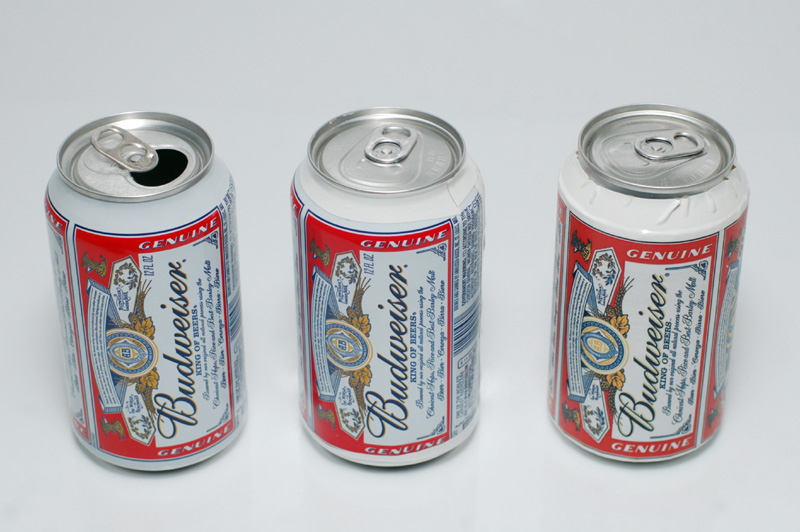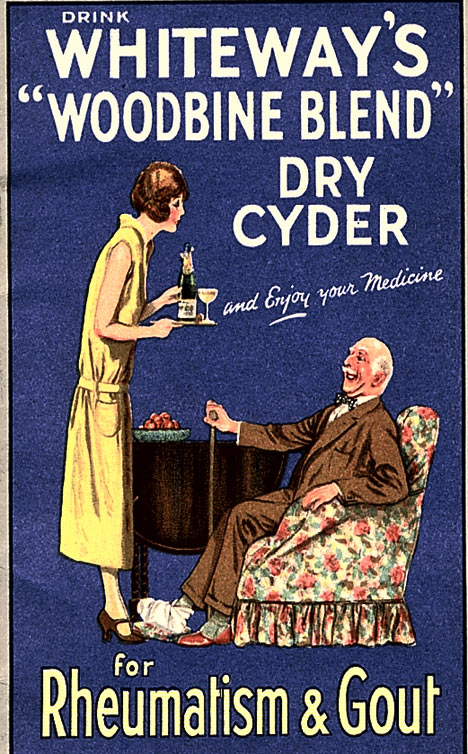Youtuber bluworm has a great process video showing how he made a latex octopus for a stop-motion film. I found this via the Craft Magazine blog, which reposted it from Sean Michael Ragan at the Make Magazine blog. He found it via Propnomicon, which finally led me to the website and blog of Tom Banwell, who makes quite the array of projects in leather and resin, many with a steampunk flair.
Faking a Beer Can
For our upcoming production of The Book of Grace by Suzan-Lori Parks at the Public Theater, we need beer. Technically, we need about ten beers per night.
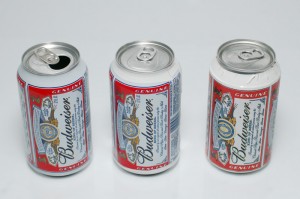
Unfortunately, in most legitimate theatres, you cannot have the actors drinking beer during a performance. You need to figure out a way to have a beer can filled with water or something equally innocuous. One way to do it is by emptying a beer can and refilling it. This can be tricky if you also want to crack the lid as part of the stage action; the sound is made because the contents are under pressure, and unless you re-pressurize the can when filling it, you’ll lose that satisfying crack noise. Your other option is to cover a can of non-alcoholic liquid with another label. You can either cut the label out of a real beer can, or manufacture one out of paper. We’ll take a brief look at both methods.
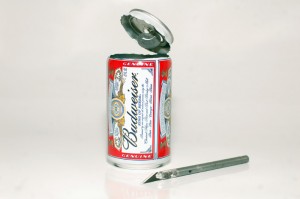
To cover one can with the label off another, you need to start by cutting off the top and the bottom. Aluminum cans cut easily with an X-Acto blade, snap-off blade, or box cutter. You don’t want to use a power tool like a band saw or jig saw, as the movement of the blade will shake the can and tear it uncontrollably. Once you remove the top and bottom, you can slice down the side to make a flat rectangle of metal.
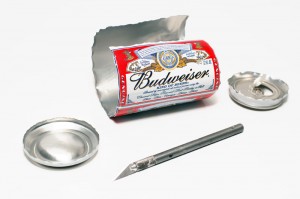
Once you have the label cut out, it’s time to attach it to your other can. Many actors prefer not to drink soda or anything too sweet during a show, as it snots up their throats. They may also have special diuretic needs that may preclude using certain drinks. Your best bet is canned carbonated water. Whether you choose seltzer, club soda, tonic water, or sparkling water depends on personal preference, but also on what the cans look like. The club soda I’ve used here has a very non-descript can that does not make itself known after it has been covered.
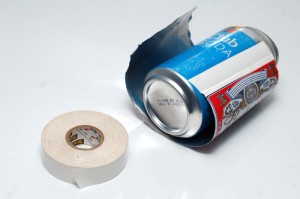
Budweiser cans have the advantage of using white as a background color; you can use white electrical tape to attach the label. If you use a different brand, you need to experiment with other types of tape. Clear packing tape is a great option if you want to avoid a colored line along the top and bottom. Make sure whatever tape you use is strong enough to keep the sharp edges of the aluminum from cutting through.
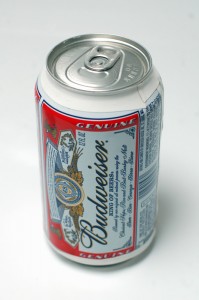
Wrapping a can of carbonated water with a paper label is another way to go. This is a good idea if your printing costs are less than the cost of acquiring beer cans. The most difficult part of this is generating the artwork. Photographing or scanning the labels can leave unrealistic shading. If you are uncomfortable using a computer graphics program to assemble and even build parts of the labels from scratch, this may not be the route for you.
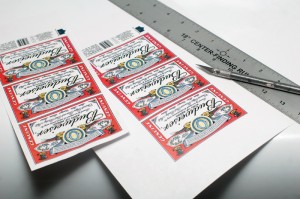
You can use tape to attach the labels on the paper ones as well, or an adhesive on the back (please excuse the messiness of the tape job in the photograph below). You may find the paper label is a lot duller than an aluminum one, so you can spray it with your favorite glossy or semi-glossy clear coat.
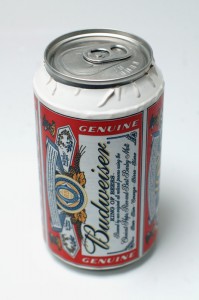
Whichever method you decide depends on the specifics of your production. There are many variables which can effect the look of the can from the audience, such as the lighting or distance to the stage. The production may have other peculiar blocking that will affect your prop choice. If the actors crush the cans, you may not wish to cover it in a second layer of aluminum, as it may make it harder or even more dangerous to pull that off.
Just remember, whatever your show needs, you “can” do it!
Faux Oil Paintings
Our upcoming production of Bloody Bloody Andrew Jackson has a gallery in the audience of 19 portraits. These were described as oil paintings of “dead white guys”. We decided to begin experimenting with printing these portraits out and seeing how we can make them look more like a painted canvas.
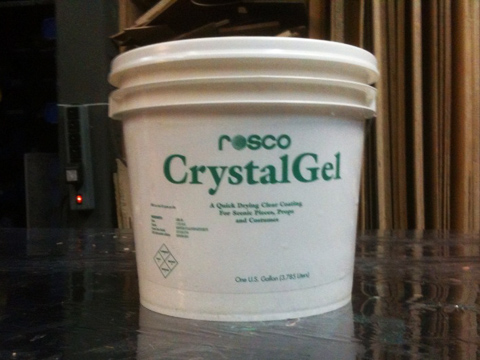
I decided to try some of the Rosco Crystal Gel we received a while back. Crystal Gel acts a little like “Sculpt or Coat”. You can brush it on in thin layers, and it will hold the texture you give it. It dries clear and hard, but it remains fairly flexible. My idea was to use it to add textural brush strokes over a picture we print out on our large plotter.
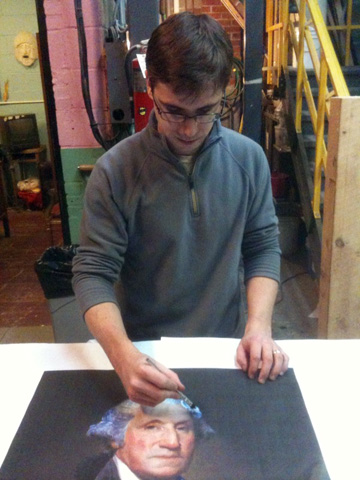
The Crystal Gel has a consistency of mayonnaise. The instructions say you can thin it with water if you want. It starts out white, which makes it easier to see where you are applying it.

You can see in the above photograph that the painting is getting wrinkled. We weren’t really surprised by that; for our next test, we mounted the paper to a piece of foam core before painting.
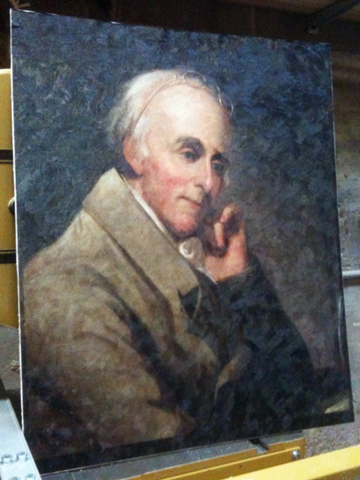
We were very happy with the final result. The photograph above doesn’t really convey the best part about this method. The texture of the dried Crystal Gel catches the light differently depending on where you stand, so as you walk by the painting, it appears to be made with thick layers of paint.
Wednesday Link-i-mage
This week, we have a visual link-o-rama, focusing on sites with vintage advertisements, posters, and other ephemera. Sometimes, you need to find historically accurate ads for props, other times, you can use them as research sources for your period.
Vintage Advertising group on Flickr
A sprawling hodgepodge of advertising and packaging pictures.
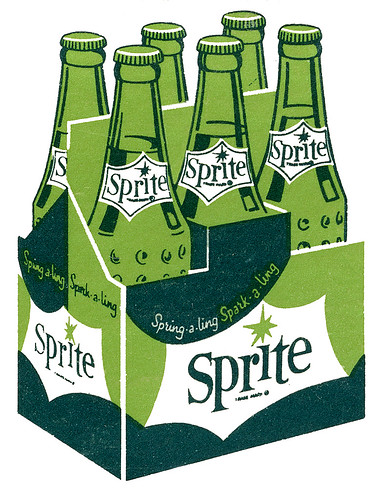
Vintage Ad Browser
A very large and very organized repository of ad images.
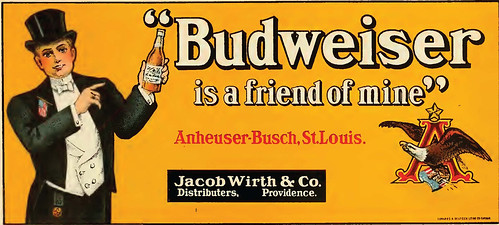
Vintage Ads
A stream-of-consciousness parade of advertisements throughout the years.
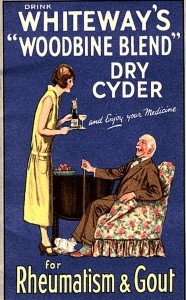
The Nifty Fifties
Ads, posters, and photographs from the 1950s.
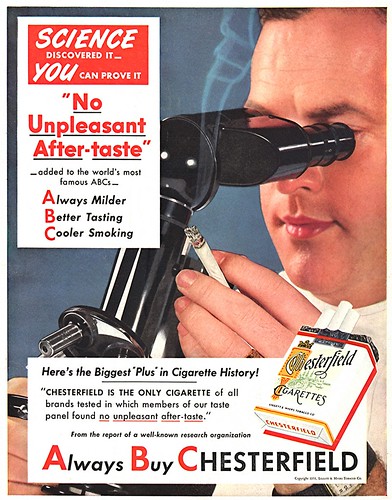
Build it Green NYC

Last week, Jay and I finally got to check out Build it Green NYC. It is a non-profit group that collects salvaged and surplus building materials, and sells them to the public for low prices.

The location is a bit of a bear (the northwestern corner of Astoria); then again, if you want cheap prices in New York City, you have to expect to get off the beaten path. The great news is that they will store your purchases for seven days. If you have to rent a car or truck (which is what New Yorkers usually have to do), you can do it after you’ve bought your goods. You don’t have to worry about spending money on a car rental only to find there’s nothing at the store you want to buy.

In addition to construction materials such as lumber, sheet goods, flooring, windows and doors, they also have a selection of furniture items like chairs and tables.
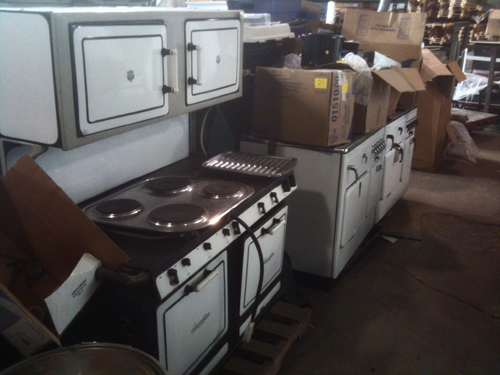
A props person would also be interested in their selection of appliances, like stoves, fridges, and other items. They’re a little more expensive than what you might find on Craigslist or other classifieds, as they only sell working items; often, your show doesn’t require an operating fridge, and you can save money hauling away something destined for the landfill. But don’t forget that you may need a fridge for your backstage area to keep prop food and consumables cold.
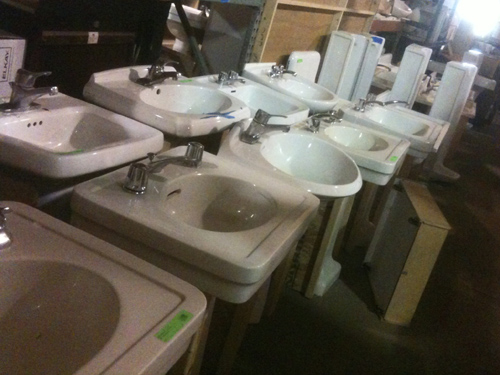
For those bathroom scenes in your production, they have several aisles dedicated to sinks, toilets, bathtubs, and an assortment of other accouterments from both residential and commercial restrooms.

If you go, don’t forget to check out their side room filled with books, records, other media, and paint.
You can find a number of unique and smaller items as well. There’s an area up front filled with the kind of sundries you might find in a thrift store or flea market. It also appears that display companies donate items, as we saw a number of mannequins as well as giant fruit sculptures.
Obviously, they accept donations. So in addition to reusing items that would have ended up in a landfill, you can also make sure the stuff you’re getting rid of stays out of a landfill. There’s a list of accepted donation items, which will also give you a better idea of the kinds of things they normally carry.

